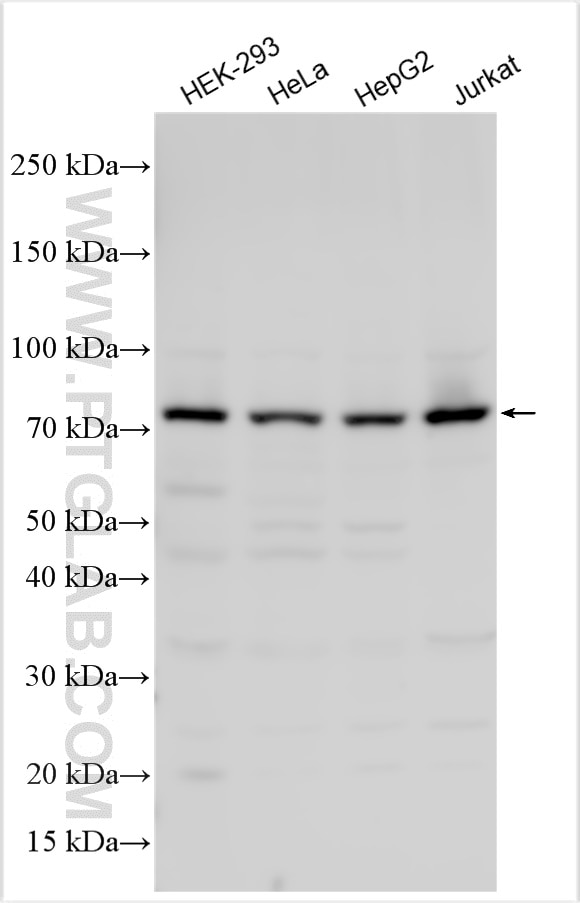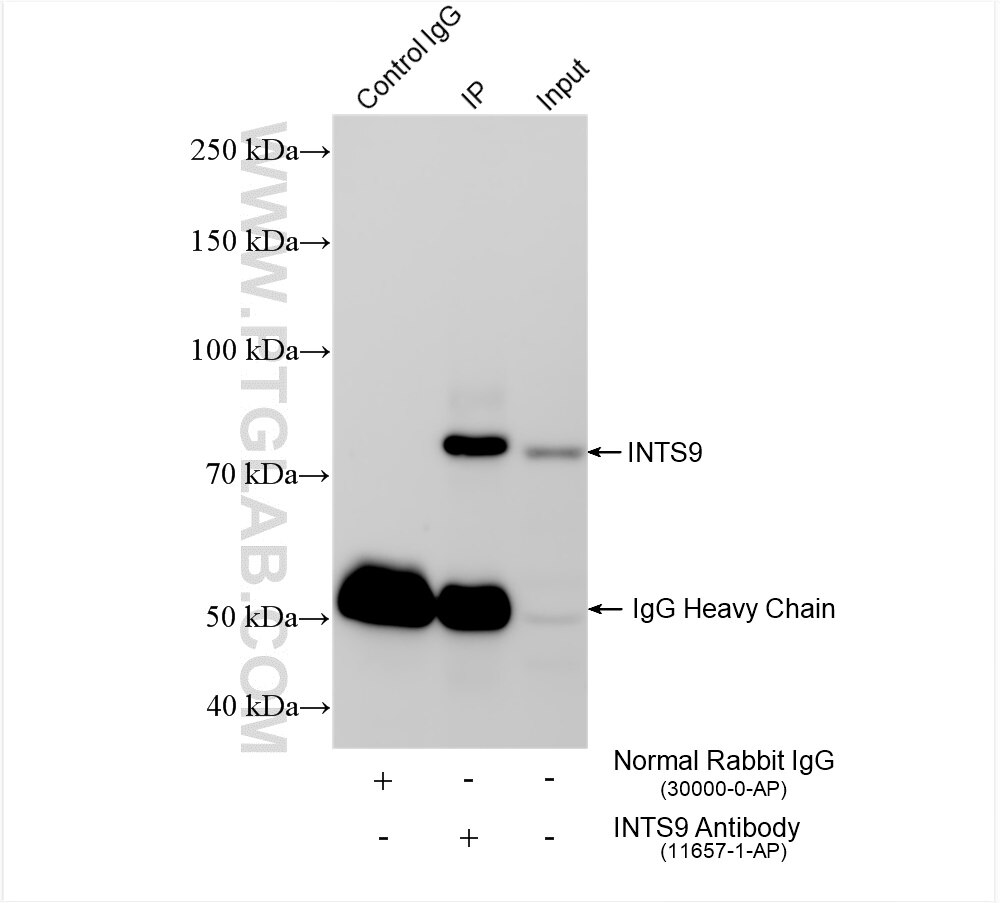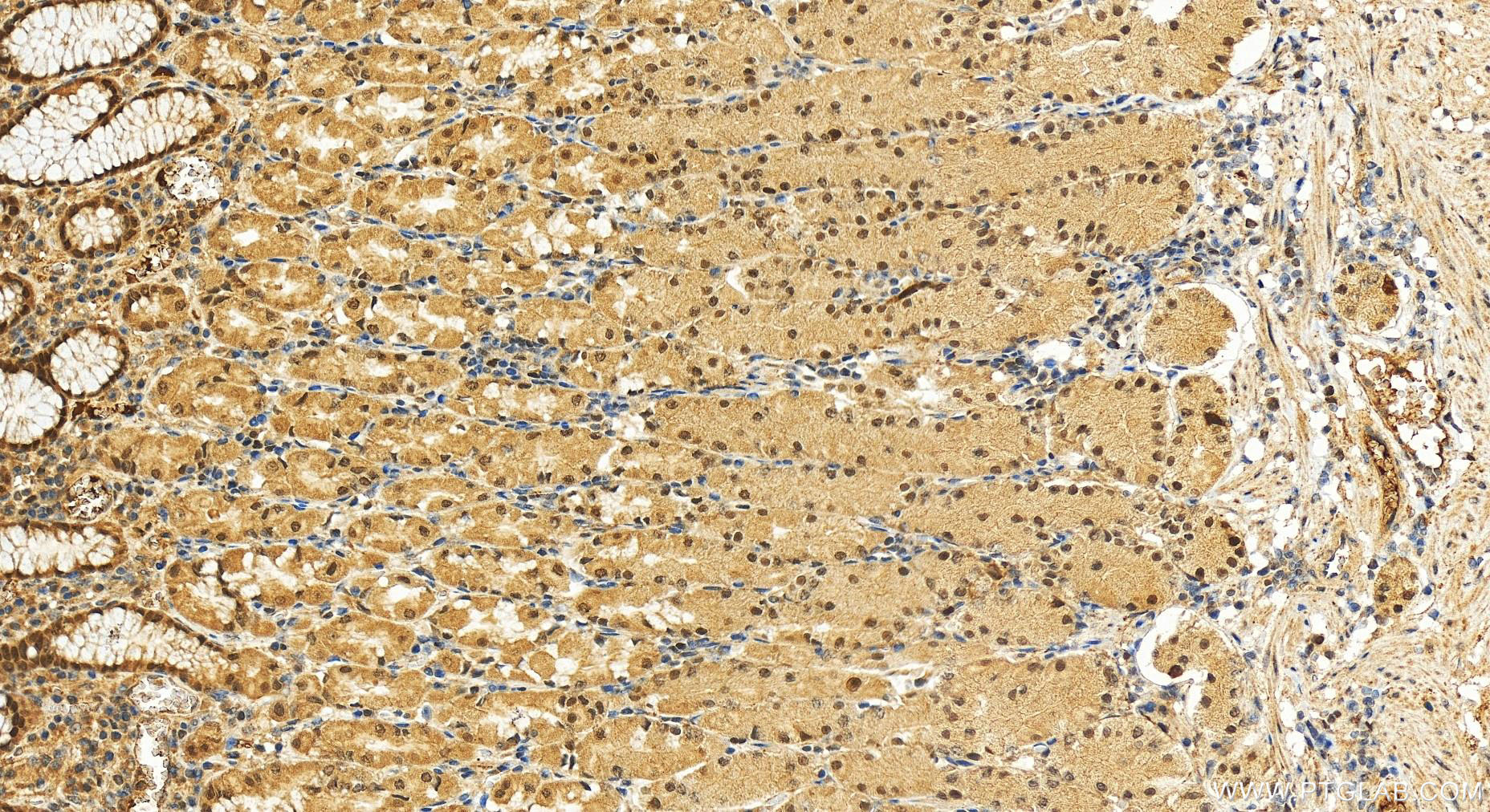Anticorps Polyclonal de lapin anti-INTS9
INTS9 Polyclonal Antibody for WB, IHC, IP, ELISA
Hôte / Isotype
Lapin / IgG
Réactivité testée
Humain
Applications
WB, IHC, IP, ELISA
Conjugaison
Non conjugué
N° de cat : 11657-1-AP
Synonymes
Galerie de données de validation
Applications testées
| Résultats positifs en WB | cellules HEK-293, cellules HeLa, cellules HepG2, cellules Jurkat |
| Résultats positifs en IP | cellules HeLa |
| Résultats positifs en IHC | tissu d'estomac humain, il est suggéré de démasquer l'antigène avec un tampon de TE buffer pH 9.0; (*) À défaut, 'le démasquage de l'antigène peut être 'effectué avec un tampon citrate pH 6,0. |
Dilution recommandée
| Application | Dilution |
|---|---|
| Western Blot (WB) | WB : 1:500-1:2000 |
| Immunoprécipitation (IP) | IP : 0.5-4.0 ug for 1.0-3.0 mg of total protein lysate |
| Immunohistochimie (IHC) | IHC : 1:50-1:500 |
| It is recommended that this reagent should be titrated in each testing system to obtain optimal results. | |
| Sample-dependent, check data in validation data gallery | |
Applications publiées
| WB | See 6 publications below |
| IP | See 2 publications below |
Informations sur le produit
11657-1-AP cible INTS9 dans les applications de WB, IHC, IP, ELISA et montre une réactivité avec des échantillons Humain
| Réactivité | Humain |
| Réactivité citée | Humain |
| Hôte / Isotype | Lapin / IgG |
| Clonalité | Polyclonal |
| Type | Anticorps |
| Immunogène | INTS9 Protéine recombinante Ag2226 |
| Nom complet | integrator complex subunit 9 |
| Masse moléculaire calculée | 658 aa, 74 kDa |
| Poids moléculaire observé | 74 kDa |
| Numéro d’acquisition GenBank | BC025267 |
| Symbole du gène | INTS9 |
| Identification du gène (NCBI) | 55756 |
| Conjugaison | Non conjugué |
| Forme | Liquide |
| Méthode de purification | Purification par affinité contre l'antigène |
| Tampon de stockage | PBS with 0.02% sodium azide and 50% glycerol |
| Conditions de stockage | Stocker à -20°C. Stable pendant un an après l'expédition. L'aliquotage n'est pas nécessaire pour le stockage à -20oC Les 20ul contiennent 0,1% de BSA. |
Informations générales
INTS9, also known as Integrator Complex Subunit 9, is part of the core cleavage module consisting of INTS4/INTS9/INTS11 involved in processing small nuclear RNA (snRNA) molecules. It is a subunit of the Integrator complex, which comprises 15 subunits (including INTS6L), and plays a crucial role in the 3' end processing of snRNAs. By participating in the biogenesis of snRNAs, INTS9 contributes to the proper functioning of the spliceosome, a cellular machinery responsible for the accurate splicing of precursor messenger RNA (pre-mRNA) molecules. This process is essential for generating mature messenger RNA (mRNA), which is subsequently translated into functional proteins.
Protocole
| Product Specific Protocols | |
|---|---|
| WB protocol for INTS9 antibody 11657-1-AP | Download protocol |
| IHC protocol for INTS9 antibody 11657-1-AP | Download protocol |
| IP protocol for INTS9 antibody 11657-1-AP | Download protocol |
| Standard Protocols | |
|---|---|
| Click here to view our Standard Protocols |
Publications
| Species | Application | Title |
|---|---|---|
Nat Commun INTS10-INTS13-INTS14 form a functional module of Integrator that binds nucleic acids and the cleavage module. | ||
Protein Expr Purif CRISPR-Cas9 mediated genetic engineering for the purification of the endogenous integrator complex from mammalian cells. | ||
Mol Cell Integrator facilitates RNAPII removal to prevent transcription-replication collisions and genome instability | ||
Mol Cell Cytoplasmic binding partners of the Integrator endonuclease INTS11 and its paralog CPSF73 are required for their nuclear function | ||
Elife Human promoter directionality is determined by transcriptional initiation and the opposing activities of INTS11 and CDK9 |




